Developing & Evaluating Marketing Plan: A Case Study of Tesco
VerifiedAdded on 2023/01/12
|7
|2014
|24
Report
AI Summary
This report provides an analysis of Tesco's marketing strategies and their application in achieving overall business objectives. It begins by examining the elements of the marketing mix (product, price, place, promotion, process, people, and physical evidence) and how Tesco utilizes these elements to promote its brand and services within the competitive UK market. The report further develops and evaluates Tesco's marketing plan, focusing on accessibility, diversification, brand positioning, awareness, and customer acquisition strategies. It highlights Tesco's approach to cost leadership, distribution channels, and promotional activities, concluding that effective marketing strategies are crucial for international business expansion and maintaining a competitive edge.
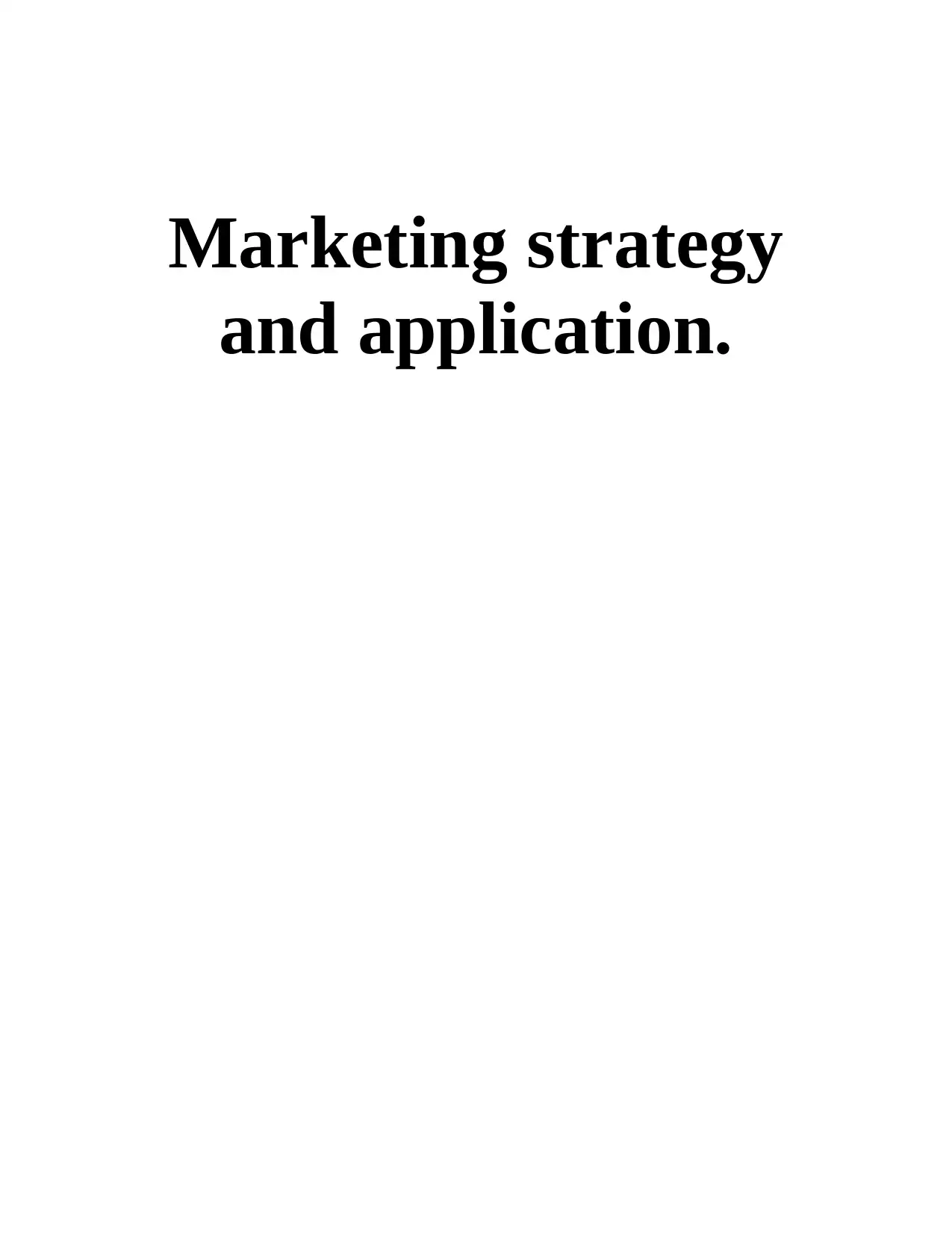
Marketing strategy
and application.
and application.
Paraphrase This Document
Need a fresh take? Get an instant paraphrase of this document with our AI Paraphraser
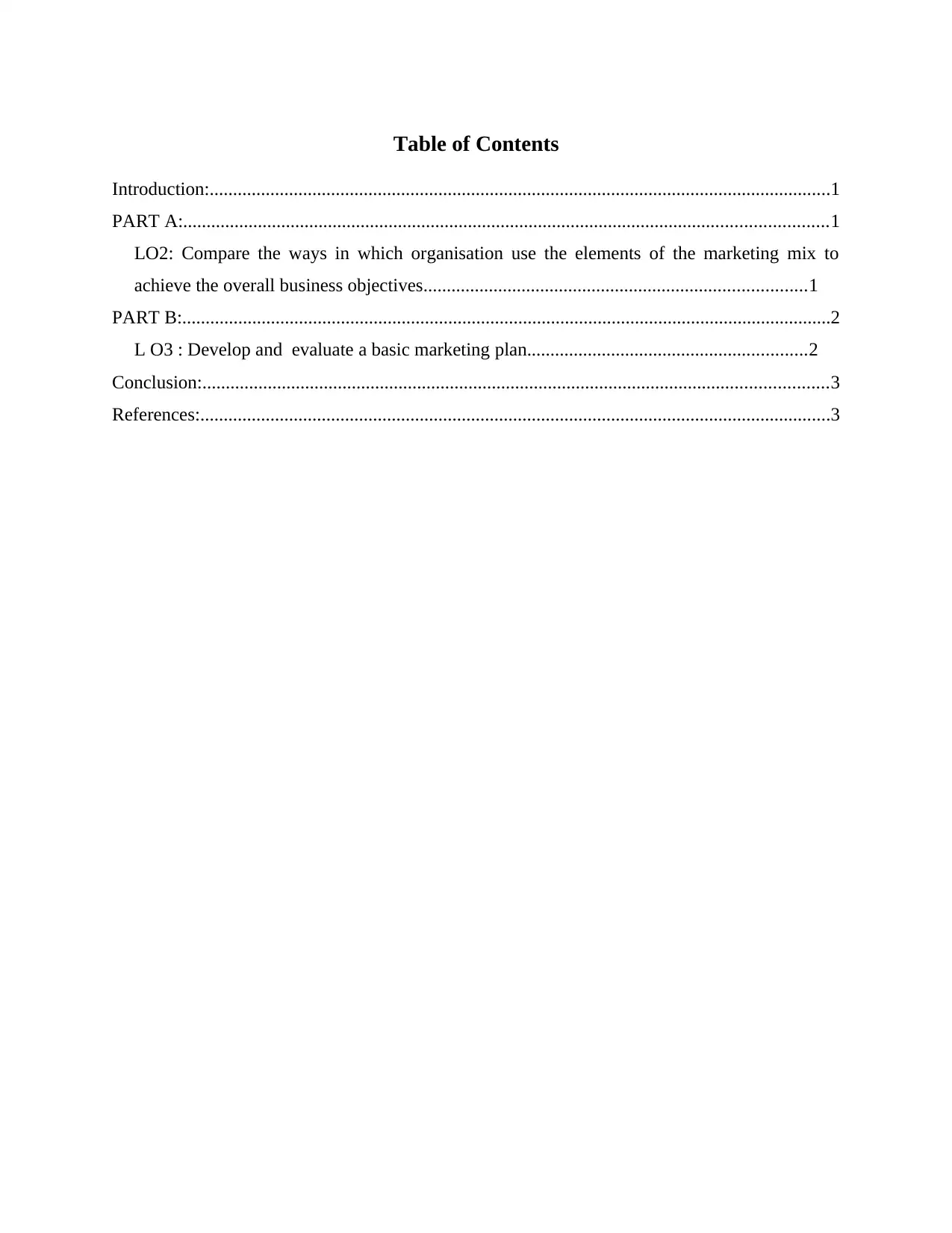
Table of Contents
Introduction:.....................................................................................................................................1
PART A:..........................................................................................................................................1
LO2: Compare the ways in which organisation use the elements of the marketing mix to
achieve the overall business objectives..................................................................................1
PART B:...........................................................................................................................................2
L O3 : Develop and evaluate a basic marketing plan............................................................2
Conclusion:......................................................................................................................................3
References:.......................................................................................................................................3
Introduction:.....................................................................................................................................1
PART A:..........................................................................................................................................1
LO2: Compare the ways in which organisation use the elements of the marketing mix to
achieve the overall business objectives..................................................................................1
PART B:...........................................................................................................................................2
L O3 : Develop and evaluate a basic marketing plan............................................................2
Conclusion:......................................................................................................................................3
References:.......................................................................................................................................3
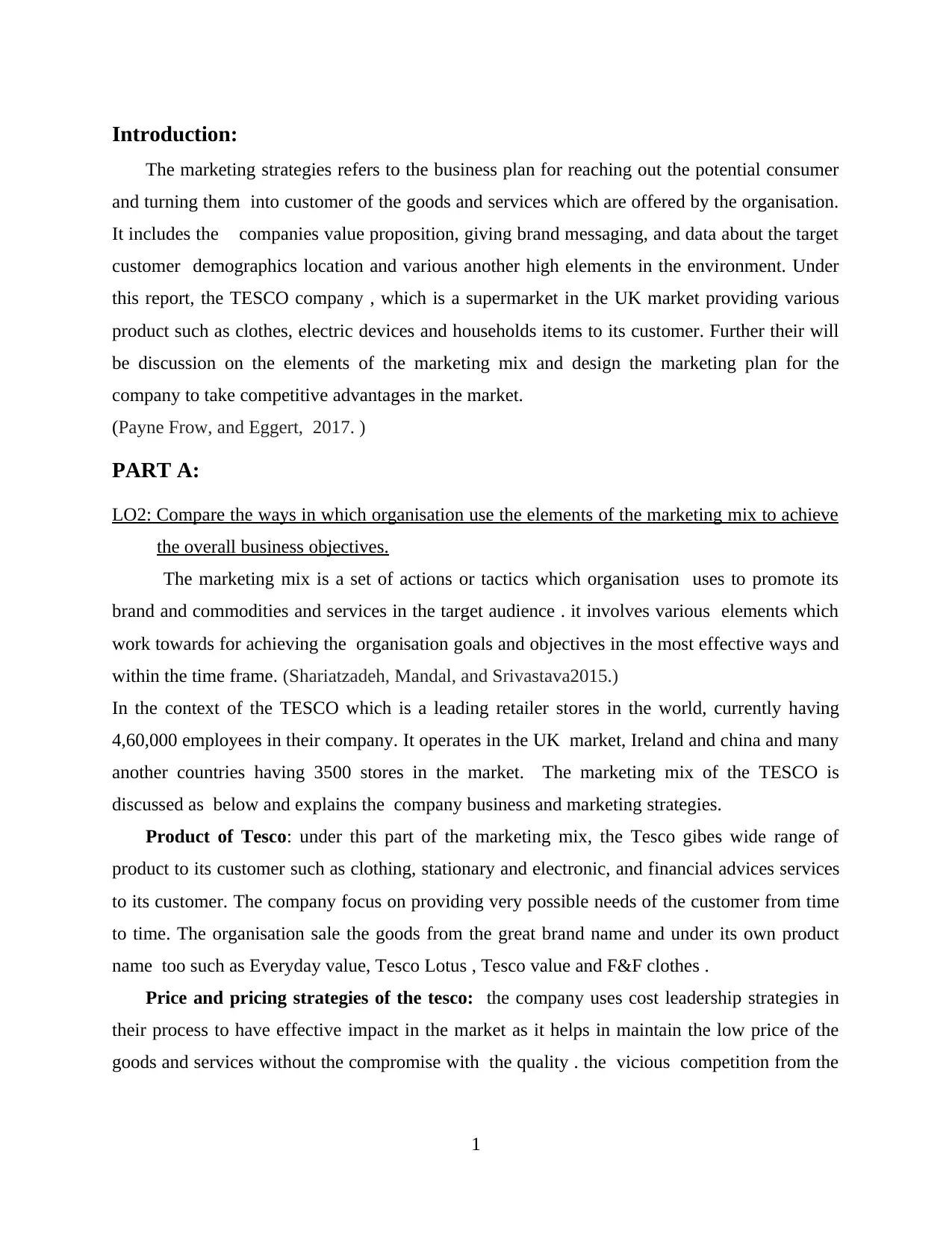
Introduction:
The marketing strategies refers to the business plan for reaching out the potential consumer
and turning them into customer of the goods and services which are offered by the organisation.
It includes the companies value proposition, giving brand messaging, and data about the target
customer demographics location and various another high elements in the environment. Under
this report, the TESCO company , which is a supermarket in the UK market providing various
product such as clothes, electric devices and households items to its customer. Further their will
be discussion on the elements of the marketing mix and design the marketing plan for the
company to take competitive advantages in the market.
(Payne Frow, and Eggert, 2017. )
PART A:
LO2: Compare the ways in which organisation use the elements of the marketing mix to achieve
the overall business objectives.
The marketing mix is a set of actions or tactics which organisation uses to promote its
brand and commodities and services in the target audience . it involves various elements which
work towards for achieving the organisation goals and objectives in the most effective ways and
within the time frame. (Shariatzadeh, Mandal, and Srivastava2015.)
In the context of the TESCO which is a leading retailer stores in the world, currently having
4,60,000 employees in their company. It operates in the UK market, Ireland and china and many
another countries having 3500 stores in the market. The marketing mix of the TESCO is
discussed as below and explains the company business and marketing strategies.
Product of Tesco: under this part of the marketing mix, the Tesco gibes wide range of
product to its customer such as clothing, stationary and electronic, and financial advices services
to its customer. The company focus on providing very possible needs of the customer from time
to time. The organisation sale the goods from the great brand name and under its own product
name too such as Everyday value, Tesco Lotus , Tesco value and F&F clothes .
Price and pricing strategies of the tesco: the company uses cost leadership strategies in
their process to have effective impact in the market as it helps in maintain the low price of the
goods and services without the compromise with the quality . the vicious competition from the
1
The marketing strategies refers to the business plan for reaching out the potential consumer
and turning them into customer of the goods and services which are offered by the organisation.
It includes the companies value proposition, giving brand messaging, and data about the target
customer demographics location and various another high elements in the environment. Under
this report, the TESCO company , which is a supermarket in the UK market providing various
product such as clothes, electric devices and households items to its customer. Further their will
be discussion on the elements of the marketing mix and design the marketing plan for the
company to take competitive advantages in the market.
(Payne Frow, and Eggert, 2017. )
PART A:
LO2: Compare the ways in which organisation use the elements of the marketing mix to achieve
the overall business objectives.
The marketing mix is a set of actions or tactics which organisation uses to promote its
brand and commodities and services in the target audience . it involves various elements which
work towards for achieving the organisation goals and objectives in the most effective ways and
within the time frame. (Shariatzadeh, Mandal, and Srivastava2015.)
In the context of the TESCO which is a leading retailer stores in the world, currently having
4,60,000 employees in their company. It operates in the UK market, Ireland and china and many
another countries having 3500 stores in the market. The marketing mix of the TESCO is
discussed as below and explains the company business and marketing strategies.
Product of Tesco: under this part of the marketing mix, the Tesco gibes wide range of
product to its customer such as clothing, stationary and electronic, and financial advices services
to its customer. The company focus on providing very possible needs of the customer from time
to time. The organisation sale the goods from the great brand name and under its own product
name too such as Everyday value, Tesco Lotus , Tesco value and F&F clothes .
Price and pricing strategies of the tesco: the company uses cost leadership strategies in
their process to have effective impact in the market as it helps in maintain the low price of the
goods and services without the compromise with the quality . the vicious competition from the
1
⊘ This is a preview!⊘
Do you want full access?
Subscribe today to unlock all pages.

Trusted by 1+ million students worldwide
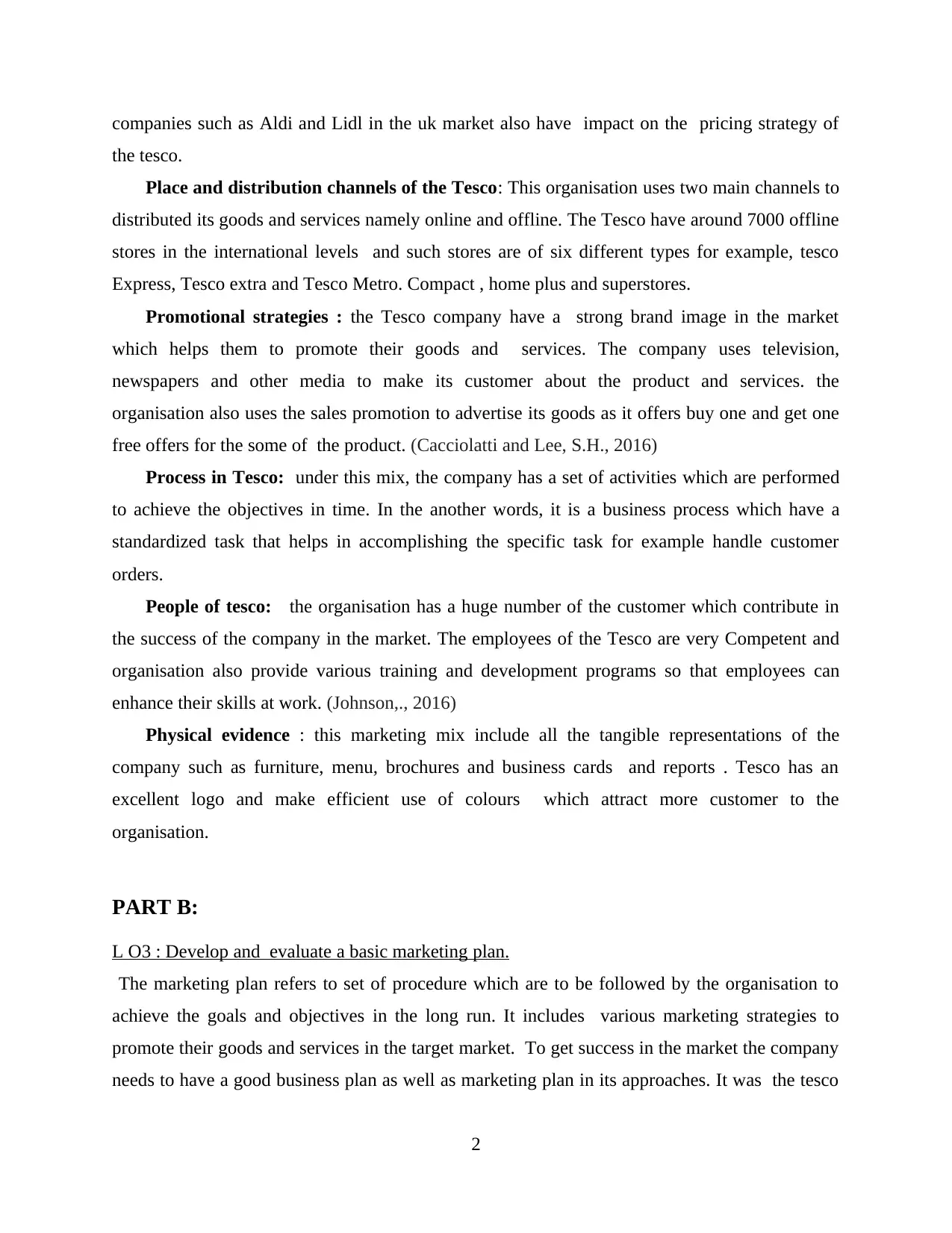
companies such as Aldi and Lidl in the uk market also have impact on the pricing strategy of
the tesco.
Place and distribution channels of the Tesco: This organisation uses two main channels to
distributed its goods and services namely online and offline. The Tesco have around 7000 offline
stores in the international levels and such stores are of six different types for example, tesco
Express, Tesco extra and Tesco Metro. Compact , home plus and superstores.
Promotional strategies : the Tesco company have a strong brand image in the market
which helps them to promote their goods and services. The company uses television,
newspapers and other media to make its customer about the product and services. the
organisation also uses the sales promotion to advertise its goods as it offers buy one and get one
free offers for the some of the product. (Cacciolatti and Lee, S.H., 2016)
Process in Tesco: under this mix, the company has a set of activities which are performed
to achieve the objectives in time. In the another words, it is a business process which have a
standardized task that helps in accomplishing the specific task for example handle customer
orders.
People of tesco: the organisation has a huge number of the customer which contribute in
the success of the company in the market. The employees of the Tesco are very Competent and
organisation also provide various training and development programs so that employees can
enhance their skills at work. (Johnson,., 2016)
Physical evidence : this marketing mix include all the tangible representations of the
company such as furniture, menu, brochures and business cards and reports . Tesco has an
excellent logo and make efficient use of colours which attract more customer to the
organisation.
PART B:
L O3 : Develop and evaluate a basic marketing plan.
The marketing plan refers to set of procedure which are to be followed by the organisation to
achieve the goals and objectives in the long run. It includes various marketing strategies to
promote their goods and services in the target market. To get success in the market the company
needs to have a good business plan as well as marketing plan in its approaches. It was the tesco
2
the tesco.
Place and distribution channels of the Tesco: This organisation uses two main channels to
distributed its goods and services namely online and offline. The Tesco have around 7000 offline
stores in the international levels and such stores are of six different types for example, tesco
Express, Tesco extra and Tesco Metro. Compact , home plus and superstores.
Promotional strategies : the Tesco company have a strong brand image in the market
which helps them to promote their goods and services. The company uses television,
newspapers and other media to make its customer about the product and services. the
organisation also uses the sales promotion to advertise its goods as it offers buy one and get one
free offers for the some of the product. (Cacciolatti and Lee, S.H., 2016)
Process in Tesco: under this mix, the company has a set of activities which are performed
to achieve the objectives in time. In the another words, it is a business process which have a
standardized task that helps in accomplishing the specific task for example handle customer
orders.
People of tesco: the organisation has a huge number of the customer which contribute in
the success of the company in the market. The employees of the Tesco are very Competent and
organisation also provide various training and development programs so that employees can
enhance their skills at work. (Johnson,., 2016)
Physical evidence : this marketing mix include all the tangible representations of the
company such as furniture, menu, brochures and business cards and reports . Tesco has an
excellent logo and make efficient use of colours which attract more customer to the
organisation.
PART B:
L O3 : Develop and evaluate a basic marketing plan.
The marketing plan refers to set of procedure which are to be followed by the organisation to
achieve the goals and objectives in the long run. It includes various marketing strategies to
promote their goods and services in the target market. To get success in the market the company
needs to have a good business plan as well as marketing plan in its approaches. It was the tesco
2
Paraphrase This Document
Need a fresh take? Get an instant paraphrase of this document with our AI Paraphraser
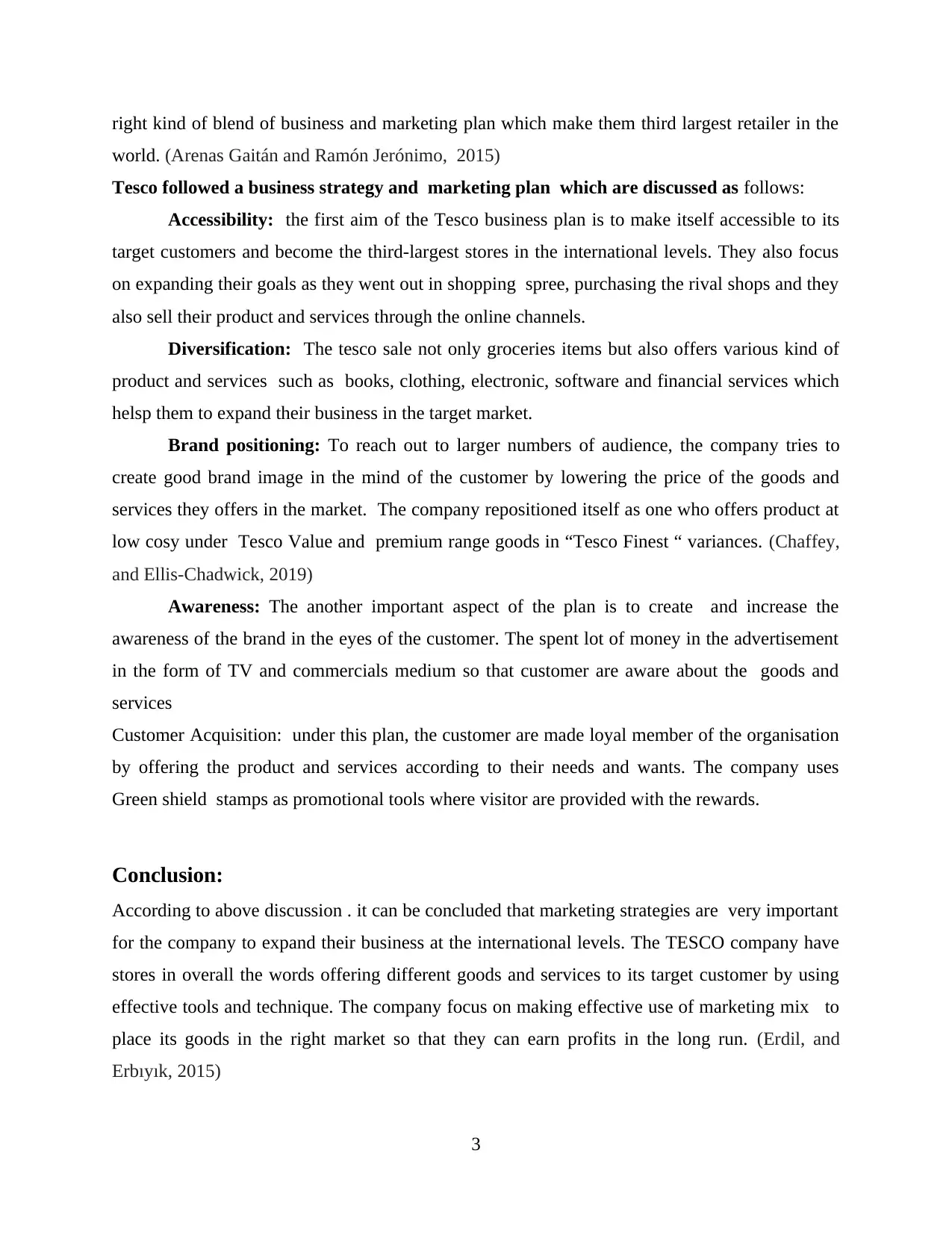
right kind of blend of business and marketing plan which make them third largest retailer in the
world. (Arenas Gaitán and Ramón Jerónimo, 2015)
Tesco followed a business strategy and marketing plan which are discussed as follows:
Accessibility: the first aim of the Tesco business plan is to make itself accessible to its
target customers and become the third-largest stores in the international levels. They also focus
on expanding their goals as they went out in shopping spree, purchasing the rival shops and they
also sell their product and services through the online channels.
Diversification: The tesco sale not only groceries items but also offers various kind of
product and services such as books, clothing, electronic, software and financial services which
helsp them to expand their business in the target market.
Brand positioning: To reach out to larger numbers of audience, the company tries to
create good brand image in the mind of the customer by lowering the price of the goods and
services they offers in the market. The company repositioned itself as one who offers product at
low cosy under Tesco Value and premium range goods in “Tesco Finest “ variances. (Chaffey,
and Ellis-Chadwick, 2019)
Awareness: The another important aspect of the plan is to create and increase the
awareness of the brand in the eyes of the customer. The spent lot of money in the advertisement
in the form of TV and commercials medium so that customer are aware about the goods and
services
Customer Acquisition: under this plan, the customer are made loyal member of the organisation
by offering the product and services according to their needs and wants. The company uses
Green shield stamps as promotional tools where visitor are provided with the rewards.
Conclusion:
According to above discussion . it can be concluded that marketing strategies are very important
for the company to expand their business at the international levels. The TESCO company have
stores in overall the words offering different goods and services to its target customer by using
effective tools and technique. The company focus on making effective use of marketing mix to
place its goods in the right market so that they can earn profits in the long run. (Erdil, and
Erbıyık, 2015)
3
world. (Arenas Gaitán and Ramón Jerónimo, 2015)
Tesco followed a business strategy and marketing plan which are discussed as follows:
Accessibility: the first aim of the Tesco business plan is to make itself accessible to its
target customers and become the third-largest stores in the international levels. They also focus
on expanding their goals as they went out in shopping spree, purchasing the rival shops and they
also sell their product and services through the online channels.
Diversification: The tesco sale not only groceries items but also offers various kind of
product and services such as books, clothing, electronic, software and financial services which
helsp them to expand their business in the target market.
Brand positioning: To reach out to larger numbers of audience, the company tries to
create good brand image in the mind of the customer by lowering the price of the goods and
services they offers in the market. The company repositioned itself as one who offers product at
low cosy under Tesco Value and premium range goods in “Tesco Finest “ variances. (Chaffey,
and Ellis-Chadwick, 2019)
Awareness: The another important aspect of the plan is to create and increase the
awareness of the brand in the eyes of the customer. The spent lot of money in the advertisement
in the form of TV and commercials medium so that customer are aware about the goods and
services
Customer Acquisition: under this plan, the customer are made loyal member of the organisation
by offering the product and services according to their needs and wants. The company uses
Green shield stamps as promotional tools where visitor are provided with the rewards.
Conclusion:
According to above discussion . it can be concluded that marketing strategies are very important
for the company to expand their business at the international levels. The TESCO company have
stores in overall the words offering different goods and services to its target customer by using
effective tools and technique. The company focus on making effective use of marketing mix to
place its goods in the right market so that they can earn profits in the long run. (Erdil, and
Erbıyık, 2015)
3
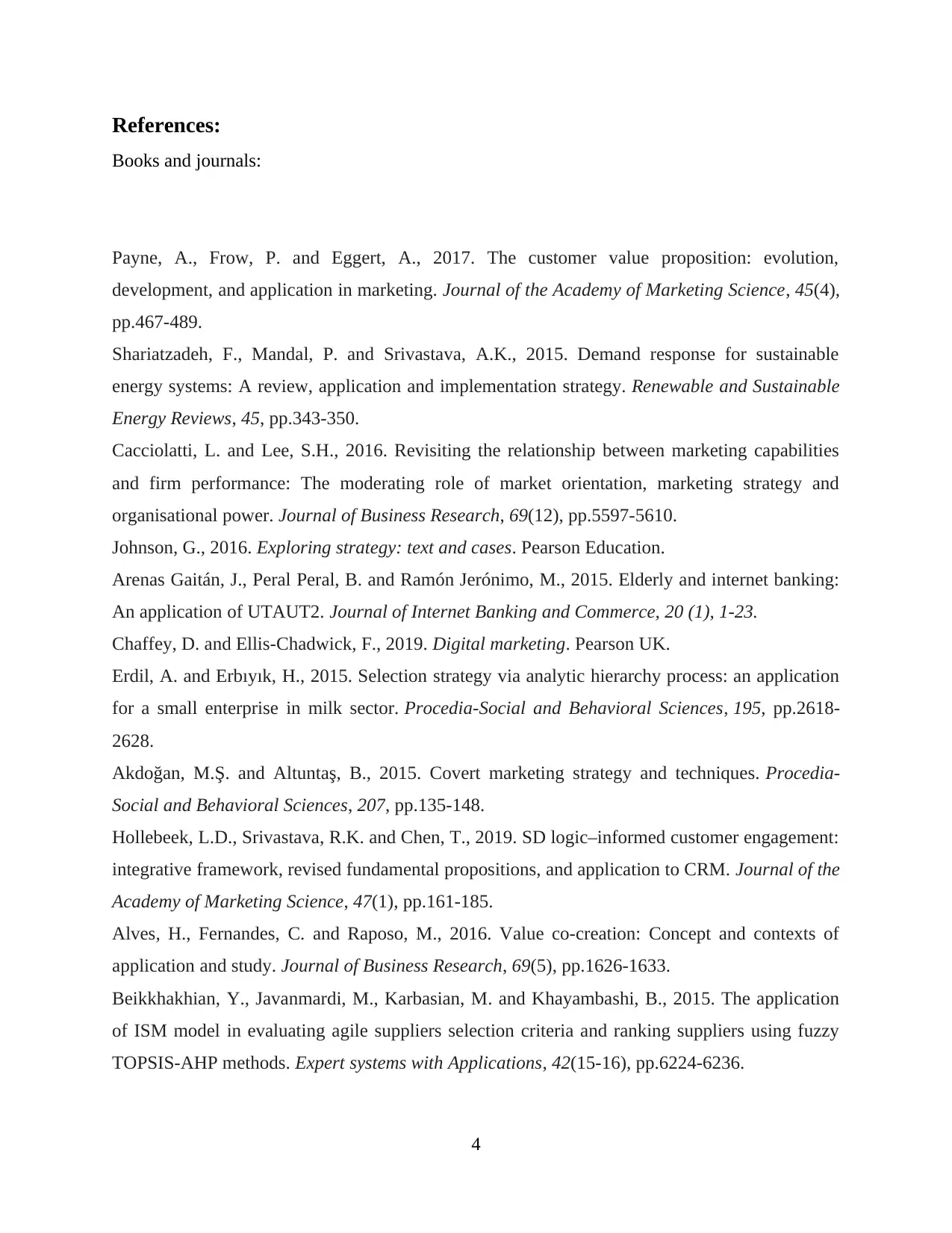
References:
Books and journals:
Payne, A., Frow, P. and Eggert, A., 2017. The customer value proposition: evolution,
development, and application in marketing. Journal of the Academy of Marketing Science, 45(4),
pp.467-489.
Shariatzadeh, F., Mandal, P. and Srivastava, A.K., 2015. Demand response for sustainable
energy systems: A review, application and implementation strategy. Renewable and Sustainable
Energy Reviews, 45, pp.343-350.
Cacciolatti, L. and Lee, S.H., 2016. Revisiting the relationship between marketing capabilities
and firm performance: The moderating role of market orientation, marketing strategy and
organisational power. Journal of Business Research, 69(12), pp.5597-5610.
Johnson, G., 2016. Exploring strategy: text and cases. Pearson Education.
Arenas Gaitán, J., Peral Peral, B. and Ramón Jerónimo, M., 2015. Elderly and internet banking:
An application of UTAUT2. Journal of Internet Banking and Commerce, 20 (1), 1-23.
Chaffey, D. and Ellis-Chadwick, F., 2019. Digital marketing. Pearson UK.
Erdil, A. and Erbıyık, H., 2015. Selection strategy via analytic hierarchy process: an application
for a small enterprise in milk sector. Procedia-Social and Behavioral Sciences, 195, pp.2618-
2628.
Akdoğan, M.Ş. and Altuntaş, B., 2015. Covert marketing strategy and techniques. Procedia-
Social and Behavioral Sciences, 207, pp.135-148.
Hollebeek, L.D., Srivastava, R.K. and Chen, T., 2019. SD logic–informed customer engagement:
integrative framework, revised fundamental propositions, and application to CRM. Journal of the
Academy of Marketing Science, 47(1), pp.161-185.
Alves, H., Fernandes, C. and Raposo, M., 2016. Value co-creation: Concept and contexts of
application and study. Journal of Business Research, 69(5), pp.1626-1633.
Beikkhakhian, Y., Javanmardi, M., Karbasian, M. and Khayambashi, B., 2015. The application
of ISM model in evaluating agile suppliers selection criteria and ranking suppliers using fuzzy
TOPSIS-AHP methods. Expert systems with Applications, 42(15-16), pp.6224-6236.
4
Books and journals:
Payne, A., Frow, P. and Eggert, A., 2017. The customer value proposition: evolution,
development, and application in marketing. Journal of the Academy of Marketing Science, 45(4),
pp.467-489.
Shariatzadeh, F., Mandal, P. and Srivastava, A.K., 2015. Demand response for sustainable
energy systems: A review, application and implementation strategy. Renewable and Sustainable
Energy Reviews, 45, pp.343-350.
Cacciolatti, L. and Lee, S.H., 2016. Revisiting the relationship between marketing capabilities
and firm performance: The moderating role of market orientation, marketing strategy and
organisational power. Journal of Business Research, 69(12), pp.5597-5610.
Johnson, G., 2016. Exploring strategy: text and cases. Pearson Education.
Arenas Gaitán, J., Peral Peral, B. and Ramón Jerónimo, M., 2015. Elderly and internet banking:
An application of UTAUT2. Journal of Internet Banking and Commerce, 20 (1), 1-23.
Chaffey, D. and Ellis-Chadwick, F., 2019. Digital marketing. Pearson UK.
Erdil, A. and Erbıyık, H., 2015. Selection strategy via analytic hierarchy process: an application
for a small enterprise in milk sector. Procedia-Social and Behavioral Sciences, 195, pp.2618-
2628.
Akdoğan, M.Ş. and Altuntaş, B., 2015. Covert marketing strategy and techniques. Procedia-
Social and Behavioral Sciences, 207, pp.135-148.
Hollebeek, L.D., Srivastava, R.K. and Chen, T., 2019. SD logic–informed customer engagement:
integrative framework, revised fundamental propositions, and application to CRM. Journal of the
Academy of Marketing Science, 47(1), pp.161-185.
Alves, H., Fernandes, C. and Raposo, M., 2016. Value co-creation: Concept and contexts of
application and study. Journal of Business Research, 69(5), pp.1626-1633.
Beikkhakhian, Y., Javanmardi, M., Karbasian, M. and Khayambashi, B., 2015. The application
of ISM model in evaluating agile suppliers selection criteria and ranking suppliers using fuzzy
TOPSIS-AHP methods. Expert systems with Applications, 42(15-16), pp.6224-6236.
4
⊘ This is a preview!⊘
Do you want full access?
Subscribe today to unlock all pages.

Trusted by 1+ million students worldwide
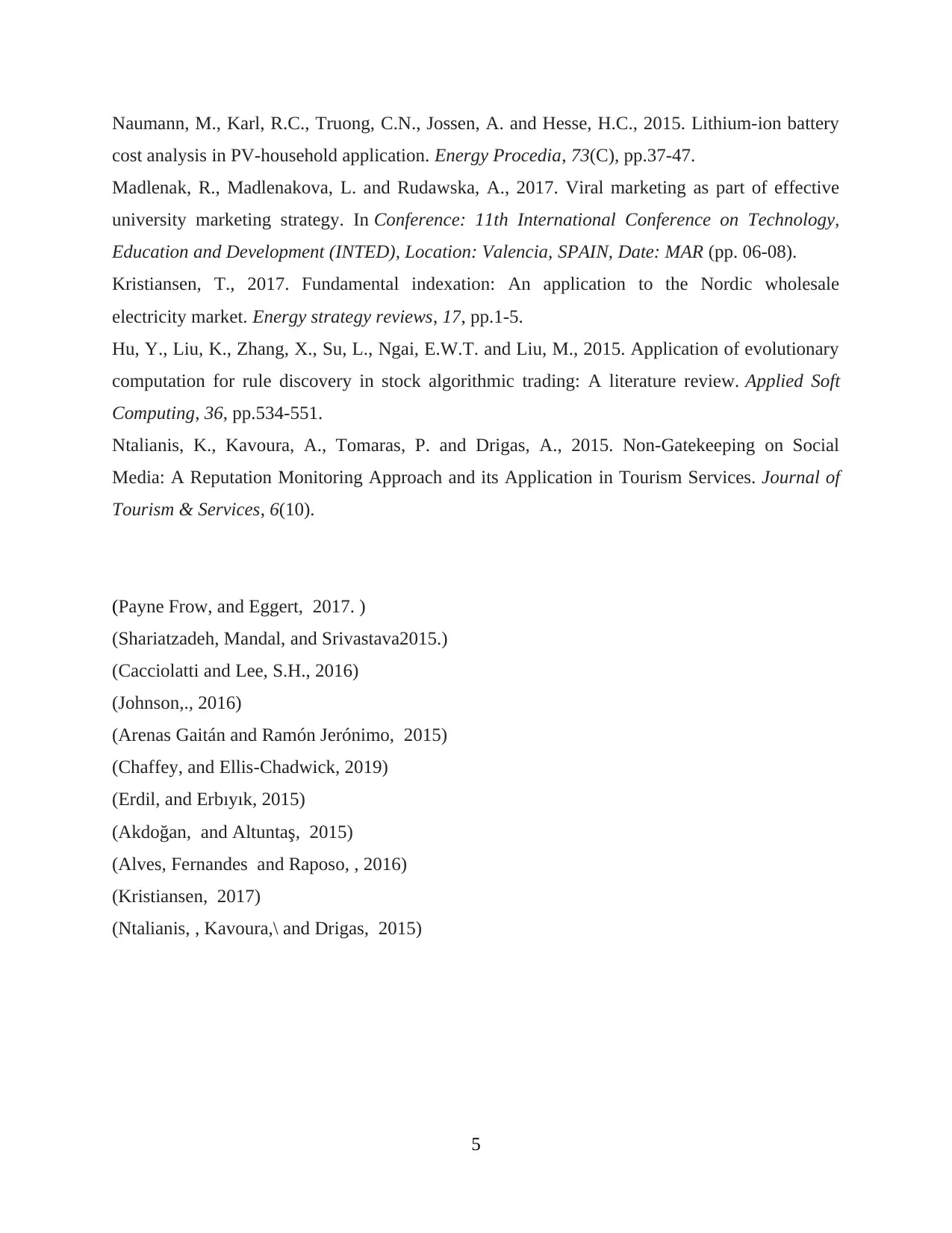
Naumann, M., Karl, R.C., Truong, C.N., Jossen, A. and Hesse, H.C., 2015. Lithium-ion battery
cost analysis in PV-household application. Energy Procedia, 73(C), pp.37-47.
Madlenak, R., Madlenakova, L. and Rudawska, A., 2017. Viral marketing as part of effective
university marketing strategy. In Conference: 11th International Conference on Technology,
Education and Development (INTED), Location: Valencia, SPAIN, Date: MAR (pp. 06-08).
Kristiansen, T., 2017. Fundamental indexation: An application to the Nordic wholesale
electricity market. Energy strategy reviews, 17, pp.1-5.
Hu, Y., Liu, K., Zhang, X., Su, L., Ngai, E.W.T. and Liu, M., 2015. Application of evolutionary
computation for rule discovery in stock algorithmic trading: A literature review. Applied Soft
Computing, 36, pp.534-551.
Ntalianis, K., Kavoura, A., Tomaras, P. and Drigas, A., 2015. Non-Gatekeeping on Social
Media: A Reputation Monitoring Approach and its Application in Tourism Services. Journal of
Tourism & Services, 6(10).
(Payne Frow, and Eggert, 2017. )
(Shariatzadeh, Mandal, and Srivastava2015.)
(Cacciolatti and Lee, S.H., 2016)
(Johnson,., 2016)
(Arenas Gaitán and Ramón Jerónimo, 2015)
(Chaffey, and Ellis-Chadwick, 2019)
(Erdil, and Erbıyık, 2015)
(Akdoğan, and Altuntaş, 2015)
(Alves, Fernandes and Raposo, , 2016)
(Kristiansen, 2017)
(Ntalianis, , Kavoura,\ and Drigas, 2015)
5
cost analysis in PV-household application. Energy Procedia, 73(C), pp.37-47.
Madlenak, R., Madlenakova, L. and Rudawska, A., 2017. Viral marketing as part of effective
university marketing strategy. In Conference: 11th International Conference on Technology,
Education and Development (INTED), Location: Valencia, SPAIN, Date: MAR (pp. 06-08).
Kristiansen, T., 2017. Fundamental indexation: An application to the Nordic wholesale
electricity market. Energy strategy reviews, 17, pp.1-5.
Hu, Y., Liu, K., Zhang, X., Su, L., Ngai, E.W.T. and Liu, M., 2015. Application of evolutionary
computation for rule discovery in stock algorithmic trading: A literature review. Applied Soft
Computing, 36, pp.534-551.
Ntalianis, K., Kavoura, A., Tomaras, P. and Drigas, A., 2015. Non-Gatekeeping on Social
Media: A Reputation Monitoring Approach and its Application in Tourism Services. Journal of
Tourism & Services, 6(10).
(Payne Frow, and Eggert, 2017. )
(Shariatzadeh, Mandal, and Srivastava2015.)
(Cacciolatti and Lee, S.H., 2016)
(Johnson,., 2016)
(Arenas Gaitán and Ramón Jerónimo, 2015)
(Chaffey, and Ellis-Chadwick, 2019)
(Erdil, and Erbıyık, 2015)
(Akdoğan, and Altuntaş, 2015)
(Alves, Fernandes and Raposo, , 2016)
(Kristiansen, 2017)
(Ntalianis, , Kavoura,\ and Drigas, 2015)
5
1 out of 7
Related Documents
Your All-in-One AI-Powered Toolkit for Academic Success.
+13062052269
info@desklib.com
Available 24*7 on WhatsApp / Email
![[object Object]](/_next/static/media/star-bottom.7253800d.svg)
Unlock your academic potential
Copyright © 2020–2025 A2Z Services. All Rights Reserved. Developed and managed by ZUCOL.



